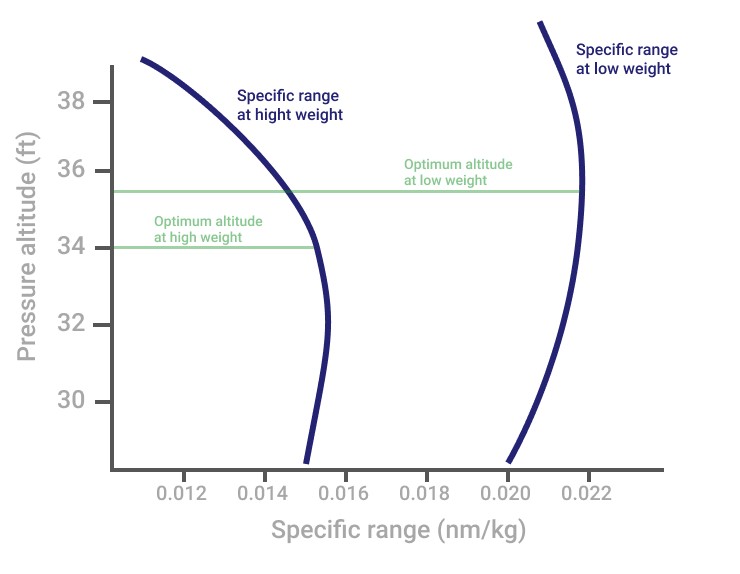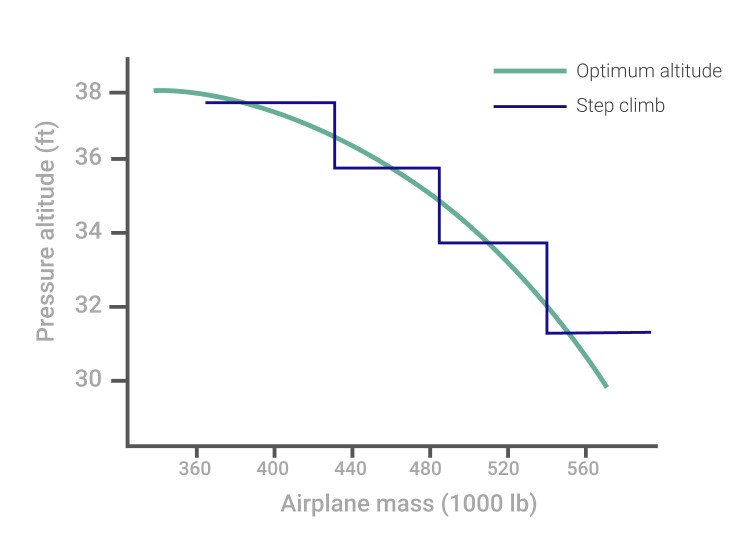¶ Introduction
As mentioned in the Cost index article, every player in the civil aviation market tries to reduce operation costs and thus save money. Reducing fuel consumption and increasing airplane usability is one of the common ways to do that. The optimum altitude concept uses aerodynamics benefits to reduce flight operation cost. It is used on a daily basis mostly by jet airplanes flying on medium and long distances.
¶ Range
There are two performance parameters in the cruise: range and endurance. Whereas endurance is about airborne time, range is more concerned with distance covered and it is sometimes referred to as "fuel mileage". For range, the concern is not only to minimize the fuel flow, but more importantly to maximize the speed. This will allow the aeroplane to travel a greater distance. Therefore, for flight operations, range is a more useful performance parameter than endurance, and one that aircraft designers continually try to improve.
Maximum range can be defined as being the maximum distance an aeroplane can travel with the minimum amount of fuel used by the aeroplane over a given distance.
There are several factors affecting range: altitude, weight, configuration and wind. Our goal today is to talk about altitude.
¶ Effect of altitude
The effect of altitude on the range of an aeroplane is important, especially for a jet airplane. Here is the formula for the specific range for a jet aeroplane:
SPECIFIC RANGE = TAS / (FUEL CONSUMPTION * DRAG)
Let's take a look on factors changing with increasing altitude:
- Fuel Consumption (FC) decreasing. Colder and more dense air allowes to increase engine RPM and decrease FC.
- TAS increasing. Operating on higher altitudes with constant CAS or IAS leads to increading TAS.
- Drag also increasing. At higher altitudes the local speed of sound is decreasing and because of greater TAS, the airplane's Mach number is also increasing. The problem with this is that beyond a certain Mach number, the compressibility factor and approaching shock wave will cause drag to increase. It is a little more complicated, but at some moment the penalty due to drag will start to outweigh the benefits of increasing TAS and reducing specific fuel consumption. It is at this point that the specific air range will start to reduce.
Therefore, the best operating altitude exists for every flight condition, allowing us to balance all positive and negative affecting factors.
¶ OPTIMUM ALTITUDE

Using the left hand blue line you will notice that there is an altitude at which the specific range is greatest; in our example this is 34 000 ft. It is defined as being the pressure altitude which provides the greatest specific range or fuel mileage at a given weight and speed. Flying higher or lower than this altitude will decrease the range of the aeroplane. This altitude is called the optimum altitude.
The optimum cruise altitude is that at which a given thrust setting results in the corresponding maximum range speed.
It is important to understand, that optimum altitude is not constant and changes over the period of a long flight as atmospheric conditions and the weight of the aircraft change.
This means that over time, as the weight decreases with fuel burn, the optimum altitude increases (check the right hand blue line on the graph).
- At the optimum altitude, operating costs will be minimum when operating in the most economical (ECON) mode;
- it is also the cruise altitude for minimum fuel burn when in the Long Range Cruise (LRC) mode.
If the aircraft is at its maximum certified level or the altitude is operationally capped, speed reduction as weight decreases will help to maintain a minimum fuel burn profile.
¶ Cruise climb vs step climb
In order for the aeroplane to maximize the specific range, the aeroplane must stay with the optimum altitude as the optimum altitude slowly increases, in other words the aeroplane must climb along the green line (see the graph). Climbing in this way is sometimes called a cruise climb. But carrying out a cruise climb is not always possible due to different limitations: air traffic control limitations, predefined flight levels in the region of flight, heavy traffic in dense airspace etc.
In order to stay close to the optimum altitude, climb may be performed by preplanned steps. This concept is called step climbs.
Step climbs essentially mean that the aeroplane climbs to about 2000 ft above the optimum altitude and levels off. As fuel is used and weight falls, the optimum altitude will increase to a point where it is again 2000 ft above the aeroplane's current level.

If the last step climb is within 200 NM of the top of descent, then the fuel saving is negated and the aeroplane should remain level.
All modern jet airplanes have step climb option in their FMS, which allows to plan climbs along the route and precheck possible fuel consumption benefit.
Example from Airbus A320 documentation: flying at an altitude that is 4000 ft below the optimum altitude will burn approximately 5% more fuel. Flying 8000 ft below the optimum altitude produces a penalty of more than 10% against trip fuel.
Over a year a typical Boeing 747 would have used something like 34000 tonnes of fuel. If an aeroplane did not even step climb and simply remained at a constant altitude during the cruise, then the aeroplane would increase its fuel consumption by 10% compared to flying constantly at the optimum altitude. This demonstrates just how important altitude and speed control are in the cruise for a typical commercial flight.
- CAE Oxford ATPL books
- Skybrary.aero
- High altitude flying presentation by FAA, 2008
- VID 531824 - Creation
- VID 310003 - Additional note
- VID 496402 - Wiki.js integration